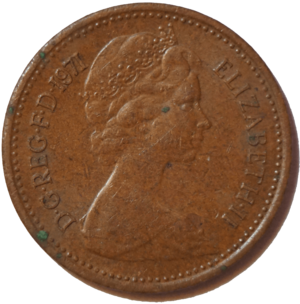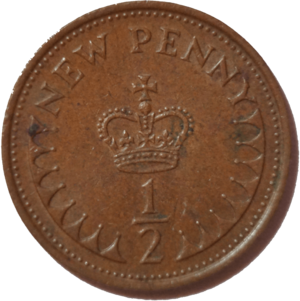Halfpenny (British decimal coin) facts for kids
| United Kingdom | |
| Value | £0.005 |
|---|---|
| Mass | 1.78 g |
| Diameter | 17.14 mm |
| Thickness | 1 mm |
| Edge | plain |
| Composition | bronze |
| Years of minting | 1971–1984 |
| Obverse | |
 |
|
| Design | Queen Elizabeth II |
| Designer | Arnold Machin |
| Design date | 1971 |
| Reverse | |
 |
|
| Design | St Edward's Crown |
| Designer | Christopher Ironside |
| Design date | 1971 |
The British decimal halfpenny (1⁄2p) coin was a denomination of sterling coinage introduced in February 1971, at the time of decimalisation, and was worth 1⁄200 of one pound. It was ignored in banking transactions, which were carried out in units of 1p.
The decimal halfpenny had the same value as 1.2 pre-decimal pence, and was introduced to enable the prices of some low-value items to be more accurately translated to the new decimal currency. The possibility of setting prices including an odd half penny also made it more practical to retain the pre-decimal sixpence in circulation (with a value of 212 new pence) alongside the new decimal coinage.
The halfpenny coin's obverse featured the profile of Queen Elizabeth II; the reverse featured an image of St Edward's Crown. It was minted in bronze (like the 1p and 2p coins). It was the smallest decimal coin in both size and value. The size was in proportion to the 1p and 2p coins. It soon became Britain's least favourite coin. The Treasury had continued to argue that the halfpenny was important in the fight against inflation (preventing prices from being rounded up). The coin was demonetised and withdrawn from circulation in December 1984.
Design
The reverse of the coin, designed by Christopher Ironside, was a representation of St Edward's Crown, with the numeral "12" below the crown, and either NEW PENNY (1971–1981) or HALF PENNY (1982–1984) above the crown.
Only one design of obverse was used on the halfpenny coin. The inscription around the portrait on the obverse was ELIZABETH II D.G.REG.F.D. 19xx, where 19xx was the year of minting. Both sides of the coin are encircled by dots, a common feature on coins, known as beading.
As on all decimal coins produced before 1984, the portrait of Queen Elizabeth II by Arnold Machin appeared on the obverse; in this portrait the Queen wears the 'Girls of Great Britain and Ireland' Tiara.
Status
The half penny coin was legal tender for amounts not exceeding 20 pence. However, legal tender in the UK has a very narrow meaning, that is unlikely to affect everyday transactions. Legal tender means that a debtor can not be successfully sued for non-payment of a debt if he has offered unconditionally to pay in legal tender. The defendant in such a case would be able to raise a defence of tender before claim.
A shopkeeper, for example, was not under any obligation to accept half penny coins for payment; conversely they have the discretion to accept payment in just half penny coins if they so wished.
Mintages
| Year | Number minted |
|---|---|
| 1971 | 1,394,188,251 |
| 1972 | In proof sets only |
| 1973 | 365,680,000 |
| 1974 | 365,448,000 |
| 1975 | 197,600,000 |
| 1976 | 412,172,000 |
| 1977 | 66,368,000 |
| 1978 | 59,532,000 |
| 1979 | 219,132,000 |
| 1980 | 202,788,000 |
| 1981 | 46,748,000 |
| 1982 | 190,752,000 |
| 1983 | 7,600,000 |
| 1984 | In proof and uncirculated sets only |
Mint Sets have been produced since 1982; where mintages on or after that date indicate 'none', there are examples contained within those sets.
Proposed quarter penny coin
A decimal quarter-penny coin (to be struck in aluminium) was also proposed (which would have allowed the pre-decimal threepence to continue to circulate with a value of 1+1⁄4 new pence), but was never produced.
See also
- Halfpenny (Irish decimal coin)

